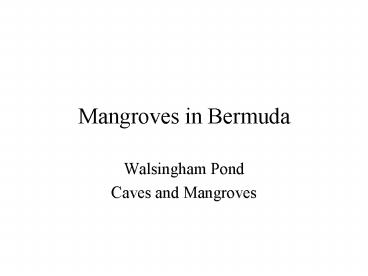Mangroves in Bermuda - PowerPoint PPT Presentation
1 / 20
Title:
Mangroves in Bermuda
Description:
Giant land crabs. Hermit crabs. Coffee bean snail. Land hermit. Mangrove crab ... Cassiopeia jellyfish. Juvenile fish. Shrimp. Lobsters. In the mud below... – PowerPoint PPT presentation
Number of Views:202
Avg rating:3.0/5.0
Title: Mangroves in Bermuda
1
Mangroves in Bermuda
- Walsingham Pond
- Caves and Mangroves
2
What is a mangrove swamp?
- It is a forest of lush green vegetation
blanketing the marshy low lying areas. - It is where trees grow that can tolerate the
salinity of the water there, and live in with
minimal soil. (halophilicsalt loving) - Includes 12 families of flowering plants and 50
species of tropical trees and shrubs.
3
The oldest
limestones (those lying closest to the underlying
basalt) have become compacted and cemented with
time to form durable rocks crossed in places by
joints (long, regular vertical cracks).
Thicknesses of limestones called beds (or strata)
are separated from each other by horizontal
surfaces called bedding planes. Rainwater is able
to pass through the limestone down the joints and
along the bedding planes the limestone is
permeable.
4
Characteristics of Mangrove Trees
- Basically are only two varieties of Mangrove on
Bermuda. Bermuda has the most northerly
mangroves. Because of cold and isolation, the two
that grow are - .red,(Rhizophora mangle) lives at the waters
edge with its prop roots in the sea. Prop roots
stabilize the tree in soft sediment.. Has smooth
reddish bark, leaves are broad and smooth,
seedlings retain on the tree. Excretes salt over
the leaf surface and through shedding of older
leaves.
5
(No Transcript)
6
- Black, (Avicennia germinans) lives in the swampy
zone between the sea and the land. Usually has
significant development of peat soil trapped by
the roots, this raises the level of the land. Has
pneumatophores (small woody fingers which enable
the roots to breathe).Leaves fairly narrow, dark
green on top, and whitish underneath. Bark is
dark, fissured and scaly, red within. Has glands
on back of the leaves to excrete salt.
7
Species found in the Mangroves
- Great Blue Herons
- Snowy Egrets
- Giant land crabs
- Hermit crabs
- Coffee bean snail
- Land hermit
- Mangrove crab
8
(No Transcript)
9
Blue Hole At Walsingham
10
(No Transcript)
11
Great Blue Heron
12
Great Egret
13
SNOWY EGRET
14
Favorite Fish Breeding Site
- The water is calm.
- The water is less saline than the ocean.
- There is a good food supply derived from the
mangrove leaves
15
Economic Importance
- Serve as sediment traps promoting aggradation
and maintaining the quality of coastal waters. - Protect coastlines from erosion during storms.
- Natural resource base for wood products.
- Habitats for rare fauna.
- Nurseries for commercially valuable crustaceans
and fish. - Educational and tourism resources.
16
The Mangrove as an Ecosystem
- Provides food for supported organisms by dropping
three tons of leaves per acre per year. - Leaves go through decomposition and become a
primary food source for fungi and bacteria. - They in turn are fed upon by nematodes, worms and
copepods. - Leaves give off tannic acid which discolors the
water, but the leaves become more protein rich as
they go through decomposition.
17
Underwater labyrinth.
- Within the underwater root system, organisms are
housed and protected including - tree oysters
- Sea squirts
- Anemones
- Cassiopeia jellyfish
- Juvenile fish
- Shrimp
- Lobsters
18
In the mud below.
- Soft sediments house numerous worms, mollusks,
crustaceans, and sea cucumbers. - Most of the animals in this area are drab in
color compared to reef life forms, but the orange
sponge and the miniature yellow sea squirt can
easily be seen from the surface.
19
Swimming in the Mangrove
20
What type of mangrove tree is this?
- Look at the root system.
- Are these prop roots?
- Are these pneumatophores?































